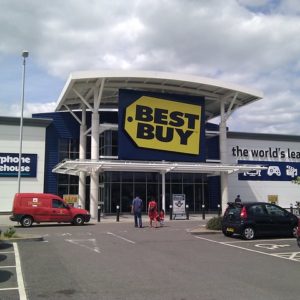Amazon may be the dominant player in the e-commerce market, but traditional brick-and-mortar retailers like Best Buy continue to adjust their business models to meet consumers’ expectations and ramp up the competition with the Big Tech giant.
In fact, Best Buy also managed to mitigate the effects of tariffs on consumer technology goods, and turned a profit in the first quarter of its 2020 fiscal year despite doomsday predictions that Amazon’s market dominance and the tariffs would create the perfect storm to sink the tech retailer.
Many economists’ research shows how Amazon engages in anticompetitive practices to ensure its dominance in e-commerce, but Amazon’s success is also the result of Amazon’s ability to accurately predict, gauge and then meet consumer expectations. Free two-day shipping, for example, isn’t a priority for most traditional brick-and-mortar retailers, even though consumers consider it a top priority.
As retail and supply chain executives discussed at a retail supply chain conference last year, traditional brick-and-mortar retailers need to start thinking about retail as a service for consumers — because what consumers want and expect from the shopping experience changes rapidly and hinges on convenience and low prices.
According to Best Buy CEO Hubert Joly, the “essence” of Best Buy’s business strategy is “the opportunity to deepen the relationships with our customers.”
“A lot of the initiatives we have underway are designed to strengthen and deepen and broaden the relationship with these customers,” he said during the Q1 2020 earnings call last week. “And when you have a relatively low market share, which we think is our case, then you are excited about the upside from increasing that penetration which could very much outweigh any kind of short term situation in the underlying macro.”
During Q1 2020, Best Buy invested in several new programs to meet this goal, like unlimited tech support for all electronics — even if they weren’t bought from Best Buy — via Best Buy’s Geek Squad.
“We continue to grow the member base at a steady rate while executing on our roadmap to drive the customer experience,” Joly said.
Best Buy also launched its new lease-to-own program in Q1 2020, which allows consumers to buy more expensive products through a payment plan in monthly increments. This encourages consumers to buy more from Best Buy, even if they can’t afford the full price of an item right away. If consumers participate in these lease-to-own programs on a Best Buy credit card, it helps them build good credit.
“The offering is consistent with our strategy to enrich lives through technology by opening up the experiences that we offer to new customers that might not otherwise have the chance to acquire the kind of solutions that we sell,” Joly said. “In many cases, it will allow us to catch customers early on in their credit history and build a relationship with them over time.”
In a push to more directly compete with Amazon, Best Buy made big supply chain improvements in Q1 2020 by deploying automation technology to box items in warehouses (just like Amazon) and new e-commerce metro centers for next-day and same-day delivery to consumers, “to optimize speed, convenience and cost to meet customer needs at the right time and place” — just like Amazon.
“Customers can order as late as 8:00 p.m. in Los Angeles and New York City and 5:30 p.m. in the other metro areas and will get their package delivered the next day,” Joly said. “Seventy-seven percent of Best Buy customers are in a ZIP Code where we are able to offer this service today and thousands of SKUs are eligible.”
Some of these delivery improvements make Best Buy delivery even faster than Amazon. Depending on how late in the day you order a product from Amazon, you may not be able to get even two-day shipping.
RapidRatings CEO James Gellert told InsideSources that Best Buy has been “really creative” about offering consumers more online order choices with fast delivery and in-store pickup, which sets the retailer apart from its peers. RapidRatings also considers Best Buy to be more financially healthy than Amazon.
“What’s notable is that [Best Buy is] not being negatively impacted the way so many other retailers have been,” he said. “I attribute a lot of that to their digital strategy. They’ve had diversification with services with tech support, and Geek Squad is performing really well. It’s good in a time when a lot of other retailers are lagging. Amazon also continues to do well, but so many companies that compete with Amazon are struggling or are expected to struggle, so it’s nice to see one that is performing well.”
Because Best Buy’s earnings were better than expected, they offset the cost of 10 percent tariffs on electronics imported from China. However, Best Buy CFO Corie Barry — who will take over the company from Joly in June — said the new 25 percent tariffs may raise prices for consumers.
“Now it’s tricky and I think you have heard it from a variety of retailers is figuring out SKU by SKU, vendor by vendor which of those tactics are going to work and which aren’t and then how that will actually play into the back half,” she said during the earnings call. “So that’s the work the team is doing and definitely we did our very best to try to size it. But there’s still a lot of work to do there.”
Tariffs could hamper Best Buy’s progress, but the retailer is now in a highly competitive position to push back on Amazon’s e-commerce supremacy.
“There really nicely positioned to withstand a shock like this,” Gellert said. “The stronger companies are so well distinguished from the [financially] weaker [retailers] that this is really the essence of it, they can withstand a problem or an external shock. Best Buy [is] materially stronger.”

